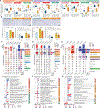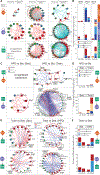Single-cell dissection of the obesity-exercise axis in adipose-muscle tissues implies a critical role for mesenchymal stem cells
- PMID: 36198295
- PMCID: PMC9558082
- DOI: 10.1016/j.cmet.2022.09.004
Single-cell dissection of the obesity-exercise axis in adipose-muscle tissues implies a critical role for mesenchymal stem cells
Abstract
Exercise training is critical for the prevention and treatment of obesity, but its underlying mechanisms remain incompletely understood given the challenge of profiling heterogeneous effects across multiple tissues and cell types. Here, we address this challenge and opposing effects of exercise and high-fat diet (HFD)-induced obesity at single-cell resolution in subcutaneous and visceral white adipose tissue and skeletal muscle in mice with diet and exercise training interventions. We identify a prominent role of mesenchymal stem cells (MSCs) in obesity and exercise-induced tissue adaptation. Among the pathways regulated by exercise and HFD in MSCs across the three tissues, extracellular matrix remodeling and circadian rhythm are the most prominent. Inferred cell-cell interactions implicate within- and multi-tissue crosstalk centered around MSCs. Overall, our work reveals the intricacies and diversity of multi-tissue molecular responses to exercise and obesity and uncovers a previously underappreciated role of MSCs in tissue-specific and multi-tissue beneficial effects of exercise.
Keywords: circadian rhythm pathway; exercise; extracellular matrix remodeling; mesenchymal stem cell; multi-tissue crosstalk; obesity; single-cell atlas; skeletal muscle; white adipose tissue; within-tissue crosstalk.
Copyright © 2022 The Author(s). Published by Elsevier Inc. All rights reserved.
Conflict of interest statement
Declaration of interests K. Grove is an employee of Novo Nordisk.
Figures






References
-
- Bray NL, Pimentel H, Melsted P, and Pachter L (2016). Erratum: Near-optimal probabilistic RNA-seq quantification. Nat. Biotechnol. 34, 888. - PubMed
Publication types
MeSH terms
Grants and funding
- R01 HG008155/HG/NHGRI NIH HHS/United States
- F32 DK126432/DK/NIDDK NIH HHS/United States
- UG3 NS115064/NS/NINDS NIH HHS/United States
- R01 HG010505/HG/NHGRI NIH HHS/United States
- R01 DK099511/DK/NIDDK NIH HHS/United States
- T32 DK007260/DK/NIDDK NIH HHS/United States
- P30 DK036836/DK/NIDDK NIH HHS/United States
- T32 DK110919/DK/NIDDK NIH HHS/United States
- U24 HG009446/HG/NHGRI NIH HHS/United States
- R01 DK132775/DK/NIDDK NIH HHS/United States
- R01 AG067151/AG/NIA NIH HHS/United States
- K23 DK114550/DK/NIDDK NIH HHS/United States
LinkOut - more resources
Full Text Sources
Molecular Biology Databases

